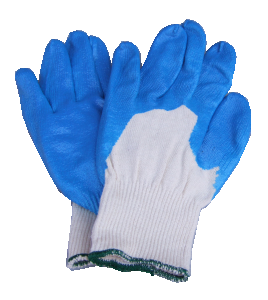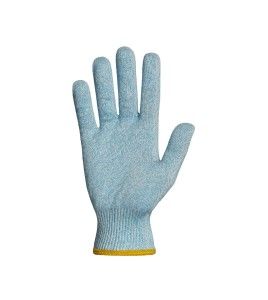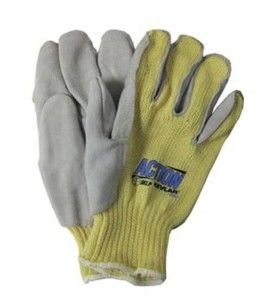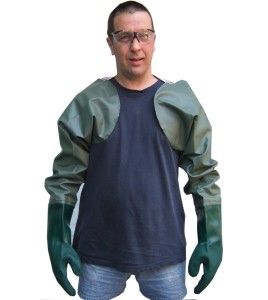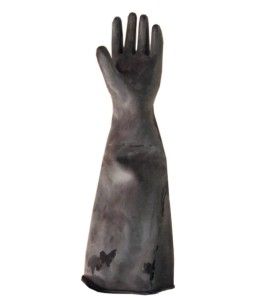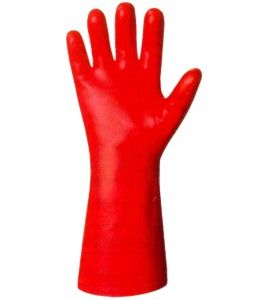Subcategories
-
Disposable Latex,...
Sylprotec offers the infamous disposable gloves used in several sectors of activities. Since the discovery of transmissible virus, the use of disposable gloves has gained considerable popularity in the healthcare sector. Nowadays, the use of disposable gloves goes beyond the health sector: they are found in the processing industries, restaurants, hair salons and many other places. The many applications requiring the wearing of protective glove generated as many models of gloves which complicates your right choice.
We recommend that you read the following steps to figure out which type of glove you need
Step 1: The choice of material
- Vinyl offers little resistance to tearing and has barely any elasticity on top of not being really resistant to any chemical substances. There is no known allergy to vinyl which makes it a hypoallergenic material and its cost is one of the lowest on the market.
- Latex offers a good resistance to tearing; it’s one of the stretchiest materials known and offers a medium resistance to chemical substances. However, latex is known to cause allergies, it cost a little more than vinyl, but less than nitrile.
- Nitrile offers an excellent resistance to tearing; it’s more or less stretchy which is compensated by the fact that it’s extremely resistant. Indeed, it resists physical breaks and chemical substance really well. There is no known allergy to nitrile, but its cost is one of the highest on the market.
Step 2: The choice of color
- Blue gloves are mainly used in the food industry due to the low prevalence of blue food. In the event of a loss of a glove or a part of it, a blue glove will be easier to spot among the food. Blue gloves are usually a little more expensive than the skin-coloured gloves.
- Colourless or skin-coloured gloves are used in the majority of applications.
- Black gloves are usually made of nitrile, but their colour has no intentional use, it’s only as a preference. Black gloves are also a bit more expensive than the colourless one.
Step 3: The choice of a powdered or powder free glove
- Disposable powdered gloves are easier to pull on and off.
- Disposable powder free gloves are commonly used to limit contamination by powder.
Step 4: The choice of thickness
- The thickness of a glove is expressed in mils (thousandth of an inch). One may find a 3 mils thick glove which is a bit thin, but may fairly do the job if used only once.
- A thickness of 4 mils or 5 mils is corresponds usually to a latex or nitrile glove. That thickness fits most applications that is, pharmaceutical, medical, etc.
- A thickness of 8 mils makes the glove one of the most resistant to tear on the market. However, one may lose some dexterity with 8 mils, so it is not suitable for a meticulous work. It is also more expensive than most other models of gloves found on the market, but they are popular among mechanics for their resistance to solvents.
Step 5: The choice of size
- Our products are available in all sizes; however we keep in stock only the median sizes, that is, small to extra-large. All other sizes are available on special order.
Our selections of gloves include:
-
Cotton or Synthetic...
Sylprotec offers many different cotton gloves and gloves made of synthetic fibers. The type of protective glove is lightweight, useful and inexpensive which makes it ideal for general applications such as handling boxes or renovate. Our selection includes the gloves:
- Polyester and cotton gloves (G211)
- Inspectors gloves for men (G216) and for women (G215)
- Light-weight inspector gloves for men (G217) and for women (G218)
- Jersey with PVC dots gloves (G223)
Cotton gloves are good to wear under waterproof gloves to reduce moisture or discomfort for people suffering from with skin condition.
-
Leather Gloves
In this section, you will find protective gloves made entirely of leather and some partly made of leather. That type of protective glove is ideal for work where worker’s skin may undergo some damages by friction or simply applications which represents a low risk of cuts.
Our gloves are usually a mix of leather and cotton – located on the top of the hand – to reduce their cost.
There are two types of leather used in the manufacture of gloves, are:
1. Smooth leather or top-grain leather, is the outer layer of the skin which is the most abrasion-resistant and also the most expensive.
2. Split leather or suede is the layer below the smooth leather which is less resistant to abrasion and tear than the top-grain one. Its advantage is primarily economic.
Here is our selection of gloves offered:
- Leather palm safety gloves with cotton back (G300)
- Leather palm safety gloves with split leather back (G311)
- Junior split leather palm safety gloves with cotton back (G306)
- Woman leather palm safety gloves with cotton back (G733)
- Split leather palm safety gloves with cotton back (G307 or G308)
- Reinforced split leather palm safety gloves with cotton back (G310)
- All leather safety gloves (G404)
One should keep in mind that the choice of a safety glove must above all be made according to the duties of the worker while remaining as economical as possible. It explains why so many models are available on the market. For more information, please contact our customer service.
-
Reusable Gloves:...
Sylprotec offers many models of coated reusable gloves for industrial applications as well as for particulars. To facilitate your choice, we have simplified the steps for selecting the best gloves for you.
1 – The choice of cuffs or sleeves
Models of gloves featuring 10" long cuffs are sometimes offered with different type of wrist: the knit cuff that tightens around the wrist and the gauntlet wrist which features a larger wrist opening. The knit wrist is popular with workers who must keep their gloves for a longer period of time. The gauntlet wrist is appreciated by workers who must put on and remove their gloves often while performing their duties.2 - The choice of polymer coating
There are many kinds and combinations of polymers on the market because the perfect glove doesn’t exist.
- Natural Rubber: Also known as latex under its natural form, under its synthetic form it is known as polyisoprene.
Advantages: cheap, extremely elastic, flexible, long-lasting, provides a good grip and mildly resistant to cuts and punctures.
Disadvantages: well-known allergen, little resistant to flames, oil and organic solvents.- Polyvinyl chloride: PVC is a thermoplastic synthetic polymer
Advantages: abrasion resistant, resistant to acids and bases in water solutions, provides a good grip.
Disadvantages: photosensitive, temperature-sensitive, poorly resistant to organic solvents.- Nitrile: A synthetic elastomer also known as polybutadiene acrylonitrile.
Advantages: extremely elastic, resistant to cuts, punctures and tearing, resistant to oils, fuels and some organic solvents.
Disadvantages: non-resistant to flames, provides a good grip even wet, not-resistant to acetone.- Neoprene: An elastomer also known as polychloroprene.
Advantages: resistant to cuts and abrasion, highly resistant to flames and heat.
Disadvantages: mildly resistant to chemicals such as oils and petroleum products.
- Polyurethane: A synthetic thermoplastic or thermosetting polymer.
Advantages: resistant to punctures, abrasion and tearing, resistant to oils, organic solvents and oxidation.
Disadvantages: little resistant to heat.- Polyethylene: A synthetic thermoplastic polymer.
Advantages: cheap, resistant to chemicals, inert (doesn’t age), resistant to cold and abrasion.
Disadvantages: non-resistant to heat, non-resilient.- Butyl rubber: A synthetic elastomer also known as polyisoprene-co-isobutylene.
Advantages: highly resistant to oxidation, corrosive chemicals, oils and solvents, lightly permeable to gases, resistant to heat, flexible, resistant to tearing.
Disadvantages: hard to vulcanise during manufacture, requires an expensive toxic method, little resistant to hydrocarbons.- Polyvinyl alcohol, PVA: A synthetic polymer.
Advantages: resistant to organic solvents.
Disadvantages: Expensive, little resistant to water solutions.To assist you in selecting the right glove, we recommend you follow the guidelines of a chemical resistance guide. For long-term exposure, we recommend you opt for a coating which provides a resistance to degradation up to 8 hours.
Our selection includes gloves coated in brief the following products:
- PVC coated nylon gloves (GS13BPVC)
- Polyurethane coated nylon gloves (GS13GPU)
- PVC coated insulated gloves (G502)
- PVC coated rough finish gloves with open wrist (G513)
- Rubber coated ribbed finish gloves (G504)
- Rubber gloves (G518-XL)
- Nitrile coated cotton gloves with gauntlet wrist (G520)
- Nitrile coated cotton gloves with knit wrist (GS15NT)
- Nitrile coated Dyneema gloves (G522)
- PVA coated gloves (GE15554)
- Neoprene coated gloves (GNE3030)
-
Heat-Resistant Gloves
Sylprotec offers a good selection of heat-resistant gloves whether you have welding or foundries tasks to perform, you work in an industrial environment or in the restauration, or just if you work in a food processing plant.
Here is a brief list of our safety gloves for heat-protection:
- Welding gloves (G601 or G603)
- Oven mittens (G611)
- Buffers with or without elastic for oven applications (G613 or G614)
- Tig-Mig gloves (G624 or G625)
- High heat protection gloves (G632)
Please note that some products are sold by the dozen, others in the pair. Consult the product’ data sheet for more information.
-
Cut-Resistant Gloves
Sylprotec offers cut-resistant safety gloves like the traditional butcher chainmail glove or the cut-resistant gloves made of Kevlar or Dyneema. Most products are available in all sizes. Products made of Dyneema or Kevlar can have coatings which improves their resistance to liquids. Moreover, fiberglass or a steel mesh may reinforce the glove to enhance the protection against cuts. Here is a brief list of the products presented:
- Chainmail safety gloves (for butchers)
- Dyneema safety gloves of different thicknesses and a choice of coatings
- Kevlar safety gloves of different thicknesses and a choice of coatings
- Puncture resistant safety gloves
- Kevlar gloves with split leather
If you can’t find the product you are looking for, please contact our customer service and it will be our pleasure to assist you. Here is our selection of anti-cut gloves:
- Ambidextrous Glove in Stainless Steel Mesh (G100)
- Level 2 anti-cut gloves made of terry cotton (G202 or G203)
- Polyurethane Coated Dyneema Knit Gloves (GS13SXPU or GS13SXGPU)
- Ambidextrous and Adjusted Kevlar® and Lycra Knit Inspector Gloves (G120)
- Kevlar Knit Gloves 10 Gauge Latex Finish with Ribbed Finish (GS10KLX)
- Chemstop ™ Dyneema® Composite Gloves Thin Nitrile Foam Coated (G522)
- Dexterity® Cut-Off Gloves Made of Kevlar® 18 Gauge Composite (GS18KGFN)
- TenActiv ™ Polyurethane Coated Cut-Resistant Gloves (GS13TAGPU)
- Kevlar Composite Coated with Nitrile Foam (GS13KFNT)
- TenActiv ™ Cut-Off Gloves Compatible with Touchscreens (GS13TAFNT)
- TenActiv ™ Anti-Cut, Polyurethane Coated Gloves, Level 5 (GSTAFGPU)
- Nylon Composite Fiber and Dyneema® Gloves (GS13FGFNT)
- TenActiv ™ Nitrile Foam Cut Resistant Composite Gloves (GSTAFGFNT)
- Emerald CX® Anti-Cut Winter Gloves (GSCXTAPVC)
-
Cold-Resistant Gloves
Sylprotec offers a good selection of safety gloves and mittens to keep your hands warm in cold environments. Whether you work outside or in a freezer, we have the gloves you need. Our selection of cold resistant gloves includes:
-
Anti-vibration Gloves,...
Sylprotec offers a couple models of anti-vibration gloves to protect workers from Raynaud’s phenomenon or the carpal tunnel syndrome which both may be caused by an extended period of exposition to vibrations. Several factors may contribute to the degradation of hands:
- The exposure time
- The stiffness of working surfaces
- The quality and ergonomy of the tool
- The position of the worker
Vibrations can cause changes in tendons, muscles, bones and joints. They may also have effects on the nervous system. The symptoms described by workers range from:
- Whitening of fingertips
- Tingling and loss of sensation in the fingers
- Loss of tactile sensitivity
- Sensations of pain and cold between periodic Raynaud’s phenomenon
- Loss of grip strength
- Bone, fingers and wrist cysts
Workers likely to be affected by these conditions usually work in housekeeping, the food industry, on assembly lines, in chipping or grinding for long periods. If you work in an area which puts you at risk of developing one of these conditions, we recommend you use one of our anti-vibration gloves. Our range of products represents the best sellers for the moment, but do not hesitate to contact us if you can’t find the product you are looking for. We are willing to increase the number of our products based on demand.
Here is our selection:
- The famous Impacto® fingerless underwear glove in cotton and Lycra (GV501)
- Fingerless Anti-Vibration Gloves with Goat Leather Palm (GVIBGHFV)
- Midfinger gloves made of cowhide and Spandex against impacts (GV400)
- AirGloves ™ Mid-finger Gloves for Abrasion and Impact (GV471)
- Blackmaxx ™ Anti-Vibration Gloves (GV473)
- AirGloves ™ Mechanic Anti-Vibration Gloves (GV408)
- Vibrastop ™ Anti-Vibration gloves in goat leather and nylon (GVIBGV)









